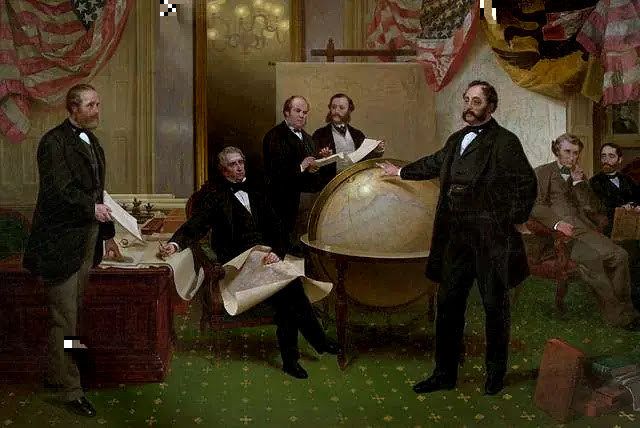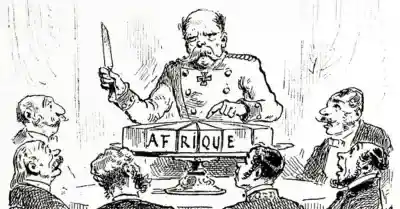The Alaska Purchase: A Historic U.S. Expansion
The Alaska Purchase happened on October 18, 1867, when the United States bought Alaska from Russia. Russia had come to North America in the 1700s, but not many Russians lived in Alaska. After the Crimean War, Tsar Alexander II of Russia thought about selling Alaska to avoid losing it to the United Kingdom. After the American Civil War, US diplomat William Seward negotiated with Russian representative Eduard de Stoeckl to buy Alaska.
On March 30, 1867, 155 years ago, Russia handed the vast territory of Alaska over to the United States after they agreed on a deal for$7.2 million, which was about 2 cents per acre. In today’s money, that’s around $129 million in 2023.
 |
| Image Credit: Getarchive.net, Alaska Purchase |
Most Americans were pleased with the purchase, believing it would improve trade with Asia. However, some people criticized it as “Seward’s Folly” or “Seward’s Icebox.” After the purchase, Russians left Alaska, and the area had few people until the Klondike Gold Rush (Alaska Gold Rush) in 1896. Fifty years after the sale, Alaska’s gold rush created over $1 billion in new wealth for the U.S. Its abundant timber, salmon, and petroleum also proved lucrative.
Alaska’s strategic importance further increased during the Cold War, becoming a vital asset for the U.S. military. Alaska was first known as the Department of Alaska, then the District of Alaska in 1884, and became the Alaska Territory in 1912. Finally, on January 3, 1959, it became the State of Alaska.
💻 Table of Contents:
- The Bering Land Bridge and Early Alaskan Settlements
- Alaska’s Fur Trade: A History of Conflict and Decline
- Russian-American Company: Trade and Administration in Alaska
- Russian Occupation, Development and Conflict on Alaska
- The Alaska Purchase: Motives behind Russia’s Sale to the United States
- The Varied Reactions to the Alaska Purchase
- The Departure of Russian Citizens from Post-Transfer Alaska
- The Sale of Alaska: Rivalries and Strategic Decisions
- Alaska: Land of Vast Resources and Natural Beauty
The Bering Land Bridge and Early Alaskan Settlements:
Approximately 40,000 to 5,000 years ago, the Bering Land Bridge (Beringia) connected Asia and America, enabling the migration of animals and early human settlements to Alaska. Human settlements were established in Alaska around 5,000 to potentially more than 30,000 years ago.
The Bering Strait, a narrow body of water, separates as the natural boundary between Russia and the United States. This important Strait is named after Vitus Bering, a Danish explorer who served the Russian Empire. In 1648, Russian explorer Semyon Dezhnev discovered the narrow waterway separating Eurasia from America, known as the Bering Strait. In 1725, Czar Peter the Great sent Vitus Bering to explore and claim territory for Russia.
In 1741, Bering’s voyage marked the first European presence in Alaska. Following his expedition, Alaska became a point of interest for other European nations, with Spain and Great Britain sending their ships to its coasts. However, it was the Russians who made the claim, asserting, “This land belongs to us!” Alaska became as an important center sector for Russian fur traders and sea animals’ businessmen.
Alaska’s Fur Trade: A History of Conflict and Decline
The fur trade was a major historical industry in North America, where Europeans traded with Indigenous peoples to obtain valuable animal furs from the 1500s to 1800s. When the Russians arrived in the mid-1600s, they started commercial fur trading. China became a major market for these furs because Chinese aristocrats loved the luxurious and waterproof fur garments.
By the late 1700s, Americans and British traders were also competing for these furs. In 1821, Tsar Alexander I of Russia tried to keep American and British ships away from Russian-controlled coasts, but this led to a new treaty in 1824 allowing all three countries to trade in Alaska.
However, the Russians also exploited Native labor, forcing Unangan hunters to collect furs and holding them as hostages. Russian traders also brought diseases like smallpox and tuberculosis, which devastated Native populations. The fur trade eventually declined because fur-bearing animals became scarce and shifting of international fashion trends.
Notably, in 2021, Israel became the first country to ban the sale of real fur. In the United States, California was the first state to ban fur sales in 2019, with the law starting in January 2023. Several cities like Los Angeles and San Francisco also have fur bans. So far, 16 towns and cities in the U.S. have banned fur sales, and more are considering it.
Russian-American Company: Trade and Administration in Alaska
Russian explorers and traders established settlements in Alaska, with Aleksei Chirikov reaching Southeast Alaska in 1741. The name “Alaska” is believed to originate from the Aleut natives’ term “Alyaska” or “Alyeska”, meaning “Great Land.” Russian settlements grew, and a fur trading company was established by Grigori Shelikov in 1781. Alexander Baranof managed Russian-Alaska trading operations, and the Russian Orthodox Church was established on Kodiak Island in 1795.
During the transfer of Alaska from Russia to the United States in 1867, the population of Russians in Alaska was relatively small. The total Russian population in Alaska during this period was estimated to be around 800 individuals. However, it’s important to note that the majority of the population in Alaska during that time consisted of indigenous Alaskan peoples, not Russians. The indigenous population of Alaska was estimated to be around 29,000-35,000 people.
 |
| Image Credit: Wikimedia Commons, Map of Alaska |
In 1799, Czar Paul I gave exclusive rights to the Russian-American Company to run Alaska’s business and administration. The Russian-American Company was founded and sponsored by the Russian government, with the backing of the Russian tsars.
The company’s operations in Alaska involved interactions with indigenous peoples and, to some extent, with American and European traders in the region. Sitka became the capital of the Alaska colony under Alexander Baranof’s leadership.
Russian Occupation, Development and Conflict on Alaska:
During the Russian occupation of Alaska, significant events shaped the region’s history. Battles between Russians and indigenous tribes in Sitka erupted in 1802, marking early conflicts in the area. In 1821, the Russian-American Company took control of trade and waters in Alaska.
Over the next 20 years, Russian explorers went into mainland Alaska, going as far north as the Yukon and Kuskokwim Rivers. The Alaska-Canada boundary was originally established in February 1825 through an agreement between Russia (then owner of Alaska) and Great Britain, the owner of Canada at the time.
The year 1840 witnessed the establishment of the Russian Orthodox Diocese for Alaska, introducing Russian church service in Alaska Native languages. Additionally, the Russians established missionary schools and churches, leaving a lasting cultural influence on the indigenous population. In 1841, Edward de Stoeckl, who was assigned to the secretariat of the Russian legation in the US, was best known today for having negotiated the American purchase of Alaska on behalf of the Russian government.
Alaska is the U.S. state closest to Russia, with the Bering Strait in the Pacific Ocean marking the nearest geographic point. The Diomedes Islands, including Russia’s Big Diomede Island and Alaska’s Little Diomede Island, are less than 3 miles apart.
In winter, it’s possible to walk across the frozen Bering Strait between these islands. Alaska is a significant gateway for flights between the Russian Far East and the United States, and the University of Alaska has a substantial number of Russian students. However, it’s important to note that crossing from Alaska to Russia is legally restricted without prior authorized access.
💻 You May Also Like:
- Cuba’s Political Landscape: Off-White Shades in the Blue Sky of the Americas
- Antarctic Discoveries: The Russian Exploration Legacy
- The Acquisition of the Virgin Islands: A $25 million US-Denmark Gold Deal
The Alaska Purchase: Motives behind Russia’s Sale to the United States
Russian control in Alaska was not without challenges. There were conflicts with indigenous Alaskan groups, notably the Tlingit people, who resisted Russian presence. Russian settlers faced geographical isolation, harsh climates, and supply difficulties. The sale of Alaska from Russia to the United States in 1867, known as the Alaska Purchase, remains a captivating chapter in the history of both nations. While the transaction has often been viewed as a controversial decision, it is essential to delve into the underlying factors and motives that led Russia to sell this vast territory.
The purchase of Alaska in 1867 ended Russia’s efforts to expand in North America. It was a big step for the United States to become powerful in the Asia-Pacific area. In 1859, Russia offered to sell Alaska to the United States to prevent Britain from getting it. The U.S. Civil War delayed the sale, but after the war, Secretary of State William Seward accepted the offer in 1867.
The U.S. Senate approved the deal on April 9, and President Andrew Johnson signed it on May 28. On October 18, 1867, Alaska officially became part of the United States. This purchase ended Russia’s presence in North America and secured the U.S. The primary reasons for Russia’s decision to sell Alaska to the United States were as follows:
Economic Considerations:
One of the primary motivations for Russia to sell Alaska was economic. By the mid-19th century, the fur trade in Alaska had significantly declined due to overhunting and diminishing fur populations. As a result, the Russian-American Company faced financial difficulties in sustaining profitable operations in the region. Selling Alaska to the United States for a substantial sum of $7.2 million provided Russia with a much-needed infusion of funds.
Geopolitical Concerns:
Russia’s decision to sell Alaska was also influenced by geopolitical considerations. The Russian Empire feared that the territory was vulnerable to foreign encroachment. With British expansion in the Pacific Northwest and the possibility of other European powers gaining a foothold in the region, Russia sought to secure the future of Alaska by transferring it to a more powerful and closer neighbor. By selling Alaska to the United States, Russia ensured that the territory would remain outside the sphere of European influence.
Strategic Military Factors:
The strategic military aspect was another significant factor in the sale of Alaska. The Russian government recognized the challenges of defending such a vast and distant territory. Maintaining military presence in Alaska would have required substantial resources and logistical support. By transferring Alaska to the United States, Russia effectively shifted the burden of defense to a country with stronger military capabilities and a shared interest in preventing foreign incursions into the region.
Domestic Political Considerations:
Domestic political dynamics within Russia also played a role in the decision to sell Alaska. Tsar Alexander II, who reigned during the sale, faced multiple challenges at home, including economic reforms and social unrest. The sale of Alaska provided a means to alleviate financial strain and divert attention from internal issues, as well as showcase the tsar’s ability to execute successful diplomatic negotiations.
The Varied Reactions to the Alaska Purchase:
The reactions to the Alaska Purchase varied among people and governments in both Russia and the United States. The Russian government, under Tsar Alexander II, saw the sale as a pragmatic decision driven by economic and strategic considerations. On the other hand, The U.S. government recognized the strategic and economic potential of Alaska.
While some Russians expressed mixed feelings and occasional regret over the sale, the decision was ultimately accepted, considering the financial benefits it provided. Initially, Americans were unsure about buying Alaska—a big, empty place. But as they discovered gold, oil, and other valuable resources there, they realized its importance. Their doubts transformed into appreciation for Alaska’s strategic and economic benefits.
The Departure of Russian Citizens from Post-Transfer Alaska:
Following the transfer of Alaska to the United States, some Russian citizens initially chose to stay in Sitka, the former capital of Russian America. However, it’s important to note that the majority of them soon made the decision to return to Russia. This repatriation was made possible through arrangements with the Russian-American Company, which facilitated their journey back to Russia, covering the associated expenses. In essence, while a few Russians stayed for a while, the majority eventually opted to leave and return to their homeland.
The Sale of Alaska: Rivalries and Strategic Decisions
In the 19th century, Russia and Great Britain were often in conflict, especially in the Pacific Ocean and during the Crimean War. As Great Britain and the United States expanded their influence in North America, Russia felt pressured. With the fur trade declining, Russia reconsidered the value of its Alaskan territory.
 |
| Image Credit: Flickr.com, Check for the purchase of Alaska |
Russia thought about selling Alaska but was unsure who to sell it to. Canada was a British colony, and since Russia and Great Britain were rivals, Russia was hesitant to sell Alaska to Great Britain. Instead, Russia sold Alaska to the United States in 1867. That same year, Great Britain created the Dominion of Canada, moving it closer to becoming an independent nation.
Canada didn’t buy Alaska for two main reasons. First, Canada wasn’t an independent country in 1867. Second, Great Britain controlled the Canadian colonies, and Russia didn’t want to sell
Alaska to its rival.
After the U.S. purchased Alaska, there was a long and bitter dispute with Canada over the exact location of the Alaskan border. The main issues were the interpretation of treaty terms and the mapping of the border through rugged and largely uncharted territory. Eventually, the dispute was settled in 1903, and Alaska’s 1,538-mile border with Canada was established. Notably, there is no direct border between the contiguous United States and Alaska.
💻 You May Also Like:
- Warsaw Pact: The Forgotten Soviet Military Alliance
- The Cold War: Collapse of Soviet’s Communist Empire & American Triumph
- American Revolutionary War: Prelude to Modern Democratic Republic and Power
Alaska: Land of Vast Resources and Natural Beauty
According to the 2020 census, Alaska comprises 665,384 square miles, nearly 86 percent of which is land, with the remaining 94,743 square miles being water. This means Alaska accounts for more than 40 percent of the United States’ total water area, with a population density of 1.10 people per square mile.
While Alaska is part of the United States, it is located over 2,000 miles away from the nearest U.S. state, Washington with comprised of Approximately 2,670 named islands. Alaska has more than 3 million lakes, over 12,000 rivers, thousands of streams and creeks, and an estimated 100,000 glaciers.
In recent years, a significant mineral deposit known as Pebble Mine (name of a proposed copper-gold-molybdenum mining project) has been discovered near Bristol Bay in Alaska. Owned by Northern Dynasty Minerals, this site holds immense riches including 67 billion pounds of copper, 82 million ounces of gold, and 4 billion pounds of molybdenum, valued at $345 billion to $500 billion.
Notably, the US Environmental Protection Agency (EPA) used a pre-emptive veto against the Pebble mine on the grounds that it poses a potential risk to the salmon population in Bristol Bay. As a result, the US Supreme Court declined to review Alaska’s challenge against the EPA’s rejection of the Pebble mine project.
Conclusion:
Despite initial doubts and criticism, the Alaska Purchase turned out to be a wise investment. Alaska’s vast natural resources, including oil, gold, and others, are now estimated to be worth over $500 billion today.
If Alaska had not been sold to the United States in 1867, it likely would have significantly impacted the United States’ dominance in the Americas and potentially enabled a greater rise of socialist and communist movements throughout Latin and Central America, altering the geopolitical balance of power in the region.
The sale of Alaska from Russia to the United States in 1867 was driven by a combination of economic, geopolitical, strategic, and domestic political factors. Russia’s desire to obtain financial resources, safeguard the territory from potential foreign threats, and reduce the burden of defending such a remote region all factored into the decision.
Russian citizens left Alaska, but the sale’s benefits became evident over time. The Alaska Purchase was a multifaceted decision that ultimately reshaped the destiny of Alaska and demonstrated the complex interplay of interests and motivations in international agreements.
Frequently Asked Questions
Russia sold Alaska to the U.S. in 1867 due to economic needs, geopolitical concerns, and the difficulty of defending such a remote territory. The sale also aimed to prevent potential foreign threats.
If Alaska had not been sold, it could have altered the geopolitical balance in the Americas, potentially limiting U.S. dominance and enabling the rise of socialist and communist movements in Latin and Central America.
Alaska became a state on January 3, 1959, after being known as the Department of Alaska, the District of Alaska (1884), and the Alaska Territory (1912).
Alaska comprises 665,384 square miles, with 86% being land (570,641 square miles) and 14% water (94,743 square miles), according to the 2020 census.
Alaska consists of approximately 2,670 named islands and is located over 2,000 miles away from Washington, the nearest U.S. state.
The fur trade was a major historical industry in North America, where Europeans traded with Indigenous peoples for valuable animal furs from the 1500s to 1800s. Israel became the first country to ban real fur sales in 2021.
Initially met with skepticism, the Alaska Purchase later proved valuable as the U.S. discovered gold, oil, and other resources, highlighting Alaska's strategic and economic importance.
The United States paid 7.2 million in1867(equivalent to129 million in 2023) to purchase Alaska from the Russian Empire. Why did Russia sell Alaska to the United States?
What if Alaska was never sold?
When did Alaska become a state?
What is the total area of Alaska?
How many islands does Alaska consist of, and how far is it from Washington?
What is the fur trade?
What was the impact of the Alaska Purchase on the United States?
How much did the United States pay for Alaska?





